

Prepared by
The Central Transportation Planning Staff:
Staff to the Boston Region Metropolitan Planning Organization
Directed by the Boston Region Metropolitan Planning Organization,
which is composed of the:
Massachusetts Department of Transportation
Metropolitan Area Planning Council
Massachusetts Bay Transportation Authority
MBTA Advisory Board
Massachusetts Port Authority
Regional Transportation Advisory Council
City of Boston
City of Beverly
City of Everett
City of Framingham
City of Newton
City of Somerville
City of Woburn
Town of Arlington
Town of Bedford
Town of Braintree
Town of Lexington
Town of Medway
Town of Norwood
Federal Highway Administration (nonvoting)
Federal Transit Administration (nonvoting)
Betsy Harvey
Alexandra Kleyman
Kim DeLauri
Ken Dumas
Kim DeLauri
David Davenport
The preparation of this document was supported by the Federal Highway Administration through MPO 3C PL contract #105757 and the Federal Transit Administration through §5303 contract #106374.
Central Transportation Planning Staff
Directed by the Boston Region Metropolitan Planning Organization. The MPO is composed of state and regional agencies and authorities, and local governments.
September 2019
Abstract
Executive Summary
Chapter 1—Introduction
Chapter 2—Existing Transportation Services
Chapter 3—Demographic Analyses
Chapter 4—Identifying Unmet Transportation Needs, Strategies to Address Them, and Priorities for Implementation
Chapter 5—Conclusion
ES-1 Summary of Unmet Transportation Needs for Seniors and People with Disabilities and Potential Strategies and Actions to Address the Needs
ES-2 State Funding Resources
3-1 Boston Region MPO Population with Disabilities by Age Cohort
4-1 Summary of Unmet Transportation Needs for Seniors and People with Disabilities and Potential Strategies and Actions to Address these Needs
4-2 State Funding Resources
ES-1 Population Projections by Age Cohort, 2010 and 2040
ES-2 Share of Comments by Topic Area
1-1 Municipalities in the Boston Region MPO
3-1 Population Ages 65 and Older, by Municipality
3-2 Share of the Population Ages 65 and Older, by Municipality
3-3 Population with Disabilities, by Municipality
3-4 Share of the Population with Disabilities, by Municipality
3-5 Population Projections by Age Cohort, 2010 and 2040
4-1 Respondent Affiliation for the Survey Conducted in the Second Phase
4-2 Share of Comments by Topic Area
Appendix A—MBTA and RTA Transit Service
Appendix B—Surveys Used to Develop the Coordinated Plan
Appendix C—Comment Letters Received During Public Review Period
The MPO complies with Title VI of the Civil Rights Act of 1964, the Americans with Disabilities Act (ADA) and other federal and state nondiscrimination statutes and regulations in all programs and activities. The MPO does not discriminate based on race, color, national origin (including limited English proficiency), religion, creed, gender, ancestry, ethnicity, disability, age, sex, sexual orientation, gender identity or expression, veteran’s status (including Vietnam-era veterans), or background. Any person who believes herself/himself or any specific class of persons to have been subjected to discrimination prohibited by Title VI, ADA, or another nondiscrimination statute or regulation may, herself/himself or via a representative, file a written complaint with the MPO. Complaints filed under federal law (based on race, color, national origin [including limited English proficiency], sex, age, or disability) must be filed no later than 180 calendar days after the date the person believes the discrimination occurred. Complaints filed under Massachusetts General Law (based on race, color, religious creed, national origin, sex, sexual orientation, disability, or ancestry) or Governor’s Executive Order 526, section 4 (based on race, color, age, gender, ethnicity, sexual orientation, gender identity or expression, religion, creed, ancestry, national origin, disability, veteran’s status [including Vietnam-era veterans], or background) must be filed no later than 300 calendar days after the date the person believes the discrimination occurred. A complaint form and additional information may be obtained at www.bostonmpo.org or by contacting the MPO staff (see below).
Boston Region MPO
Central Transportation Planning Staff
10 Park Plaza, Suite 2150
Boston, MA 02116
857.702.3700 (voice), 617.570.9193 (TTY)
617.570.9192
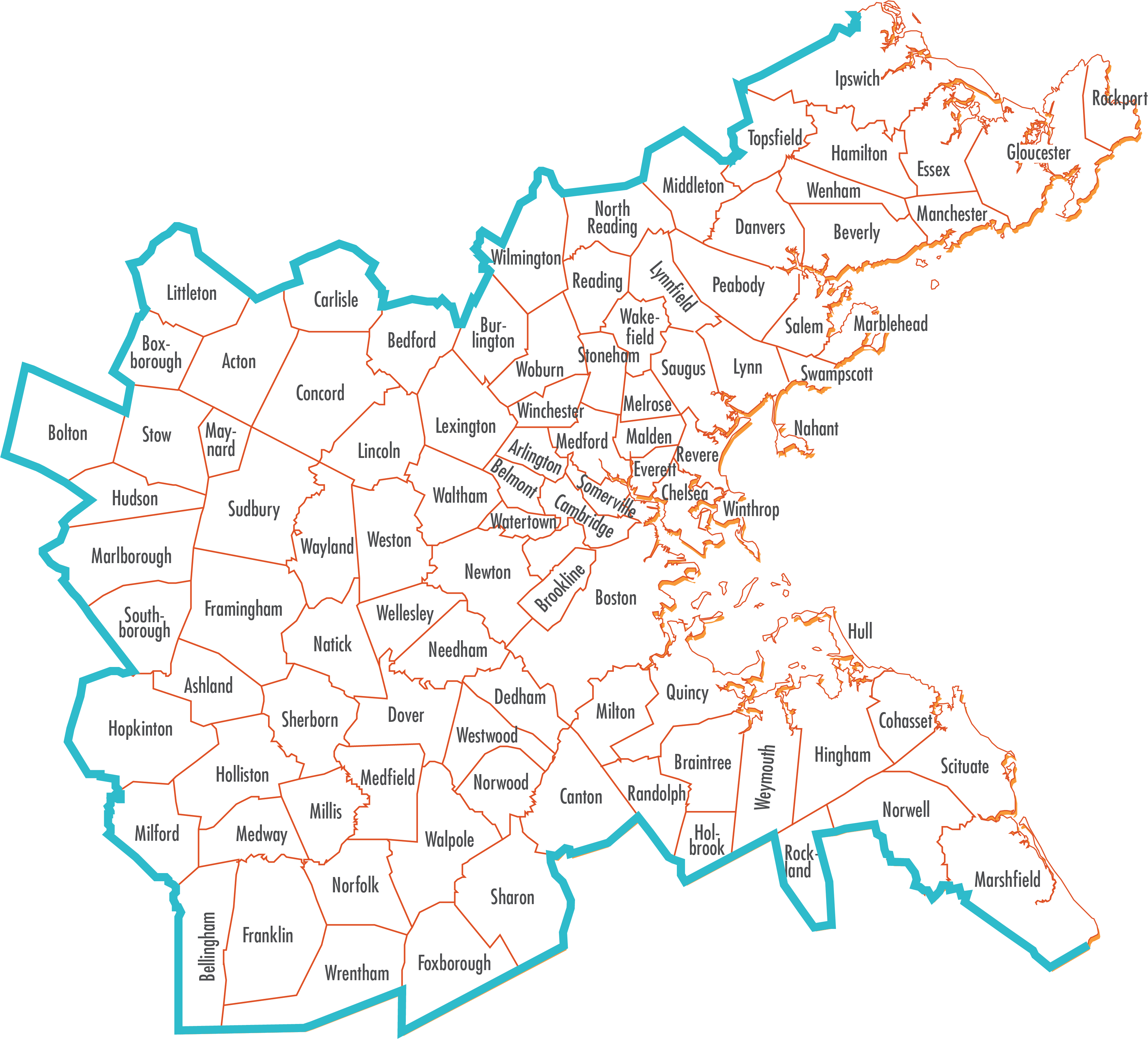
The Coordinated Public Transit–Human Services Transportation Plan (Coordinated Plan) documents the Boston Region Metropolitan Planning Organization (MPO) area’s current transportation providers; unmet transportation needs for seniors (people ages 65 years old and older) and people with disabilities; strategies and actions to meet the unmet needs; and priorities for implementation. The primary purpose of the Coordinated Plan is to improve coordination among transit agencies and other transportation providers to better serve the transportation needs of seniors and people with disabilities. The Coordinated Plan accomplishes this by setting regional priorities for transportation investments and initiatives for human services and public transit coordination.
In addition, the Coordinated Plan guides organizations in the region to develop proposals that are eligible to receive funding from the Federal Transit Administration’s (FTA) Section 5310 program, Enhanced Mobility of Seniors and Individuals with Disabilities Program. This program provides capital and operations assistance for services that improve mobility for seniors and people with disabilities. In Massachusetts, the Massachusetts Department of Transportation manages the application process for the Section 5310 program, under the Community Transit Grant Program (CTGP). Per FTA guidance, the MPO’s Coordinated Plan is updated every four years in concert with the Long-Range Transportation Plan. This 2019 update can be used by CTGP applicants starting in the state fiscal year 2021 application cycle.
The primary purpose of the Coordinated Public Transit–Human Services Transportation Plan (Coordinated Plan) is to improve coordination among public transit agencies and other transportation providers to better meet the transportation needs of seniors and people with disabilities. The Coordinated Plan accomplishes this by identifying the transportation needs of these populations and setting regional priorities for transportation investments and initiatives for human services and public transit coordination. In addition, the Coordinated Plan guides organizations in the region in the development of their applications for the Federal Transit Administration’s (FTA) Section 5310 program, Enhanced Mobility of Seniors and Individuals with Disabilities Program.
Within the Boston region, this plan defines the following:
Per FTA recommendation, the Boston Region Metropolitan Planning Organization’s (MPO) Coordinated Plan is updated every four years in conjunction with the Long-Range Transportation Plan (LRTP). This 2019 update to the Boston region’s Coordinated Plan replaces the MPO’s 2015 Coordinated Plan and should be referred to in Community Transit Grant Program applications beginning with the state fiscal year 2021 application cycle.
Chapter 2 documents existing transportation services in the Boston region. Numerous public, nonprofit, and private providers operate transit services in the region.
The region’s transit providers that serve Boston region MPO towns include the following providers:
In addition to the MBTA and RTAs, several Transportation Management Associations (TMA) operate within the region. A TMA is a membership-based coalition of businesses, universities and other institutions, and municipalities that collaborate to provide transportation solutions for commuters. There are 10 TMAs in the Boston region. TMAs provide transportation for employees of the TMA membership and sometimes for the public.
Locally, many municipalities offer transportation services for seniors and/or people with disabilities. Municipal Councils on Aging (COA) provide support services that may include transportation to seniors, families, and caregivers. Some municipalities also offer local transportation for all residents, such as Lexington’s Lexpress bus.
Some nonprofit organizations and local private institutions operate transit services in the region for employees, patients, and students between their various campuses and nearby neighborhoods. Smaller services also provide local transportation for seniors or people with disabilities. Private for-profit senior care companies and taxi companies around the region may also provide transportation.
In addition, several long-distance transportation providers operate within the region. For-profit companies offer bus or ferry service for long-distance commuting and tourism. Meanwhile, Amtrak, a quasi-public corporation, provides rail service to the Boston region.
Finally, several volunteer driver programs operate within the Boston region that provide transportation for seniors and people with disabilities. These operate within specified municipalities, are restricted to seniors and people with disabilities, and may only provide certain types of trips.
Chapter 3 provides demographic data about seniors and people with disabilities in the region as well as demographic projections for the senior population for 2040. Developing an understanding of current and changing demographics about these populations provided important background information for staff to conduct public engagement to identify unmet transportation needs throughout the region.
In the Boston region, 13.4 percent of the population falls into the FTA definition of a senior (individuals ages 65 years or older). As of 2010, Boxborough has the fewest number of seniors, with 421 individuals, while Boston has the most, with 62,237 individuals.
In the Boston region, 459,866 people, or 10.4 percent of the population, reported having a disability on the 2013–17 American Community Survey.1 Boxborough has the lowest share of people with disabilities in the Boston region, with 5 percent, while Holbrook has the highest share, with 16.7 percent.
Seniors in the Boston region are more likely than the rest of the population to have a disability. About one-third of seniors have a disability, compared to the 7.6 percent of people between the ages of 18 and 64 and the 3.9 percent of people younger than age 18 who have a disability, although there are more people in the 18 to 64 cohort who have a disability.
Demographic projections show that the share of the population 75 years of age or older is projected to increase between 2010 and 2040.2 Figure ES-1 shows the current and projected age cohort breakdowns of the population living in households in 2010 and 2040.3
Figure ES-1
Population Projections by Age Cohort, 2010 and 2040
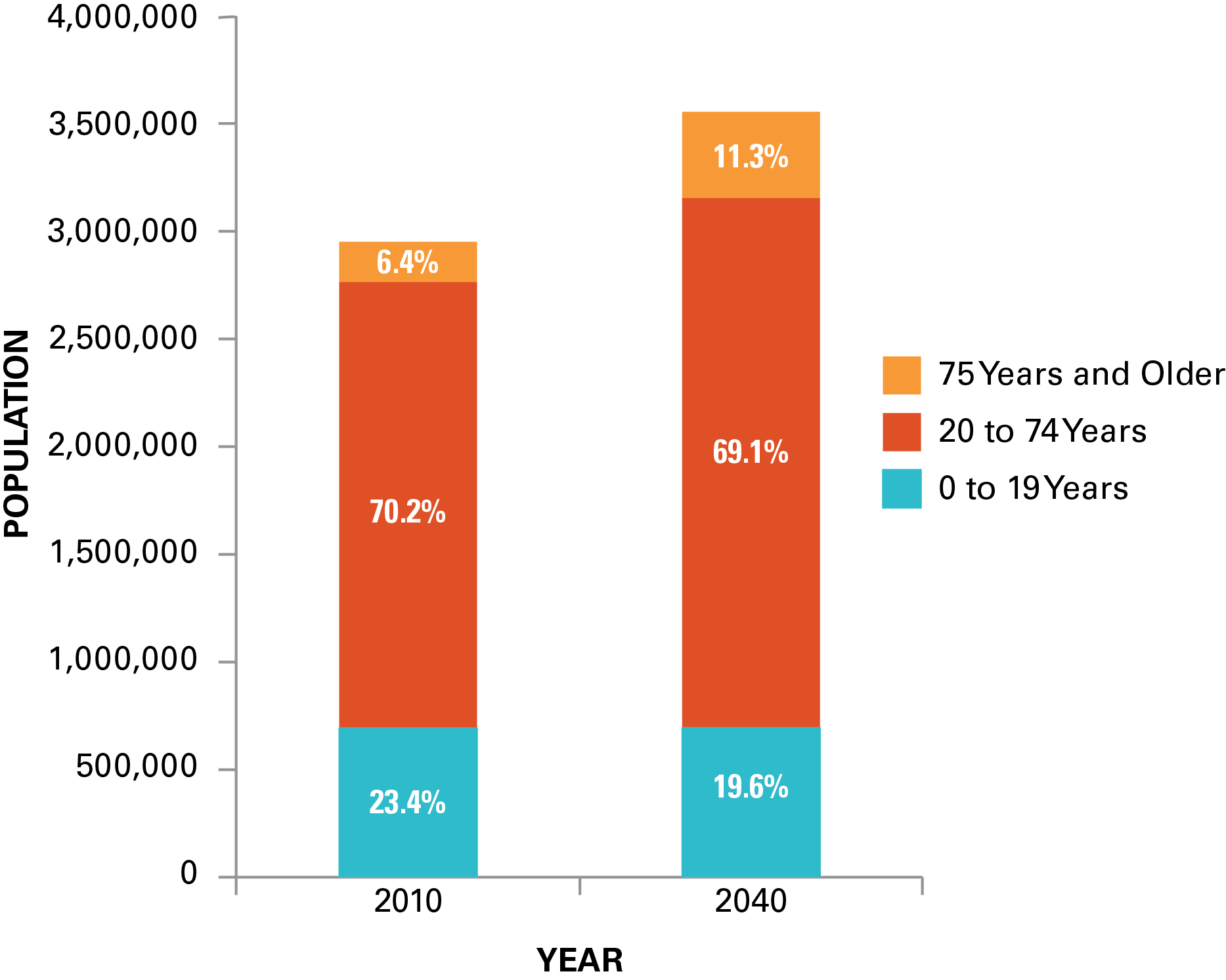
Source: Data from the University of Massachusetts Donahue Institute and the
Metropolitan Area Planning Council.
Demographic projections have not been developed for people with disabilities. However, approximately one-third of seniors have a disability. With a projected increase in the share of the population in this age cohort, the share of the population with disabilities may also increase. These data suggest that the MPO and other transportation planning agencies and providers will increasingly need to plan for the transportation needs of seniors and people with disabilities as they make up an increasing share of the region’s population.
Chapter 4 describes the public outreach conducted and key findings that led to the definition of the unmet needs, strategies, and priorities for mobility improvements for seniors and people with disabilities in the Boston region.
FTA divides eligible 5310 program project types into traditional capital projects and nontraditional projects, while eligible recipients are divided into direct recipients and subrecipients.
FTA defines traditional capital projects as those planned, designed, and carried out to meet the special transportation needs of seniors and people with disabilities when public transit is insufficient, inappropriate, or unavailable. Nontraditional projects are defined as those that exceed transportation services required by the Americans with Disabilities Act (ADA), improve access to fixed-route service and decrease reliance by people with disabilities on ADA-complementary paratransit service, or provide alternatives to public transit that assist seniors and people with disabilities with transportation. FTA regulations also specify how the funding should be split between these two project types—at least 55 percent of program funds must be used for traditional projects and the remaining 45 percent may be used for nontraditional projects.
Direct recipients of Section 5310 program funding must be states or local government authorities, while nonprofit organizations and other entities that operate public transit services may be subrecipients.
MPO staff conducted outreach through in-person events and online surveys with municipal officials, transit providers, human services agencies, and members of the public for feedback on unmet transportation needs for seniors and people with disabilities.
Based on 914 comments received, MPO staff divided input into the following topic areas:
Figure ES-2 below shows the breakdown of comments (relating either to needs or strategies and actions) by topic area.
Figure ES-2
Share of Comments by Topic Area
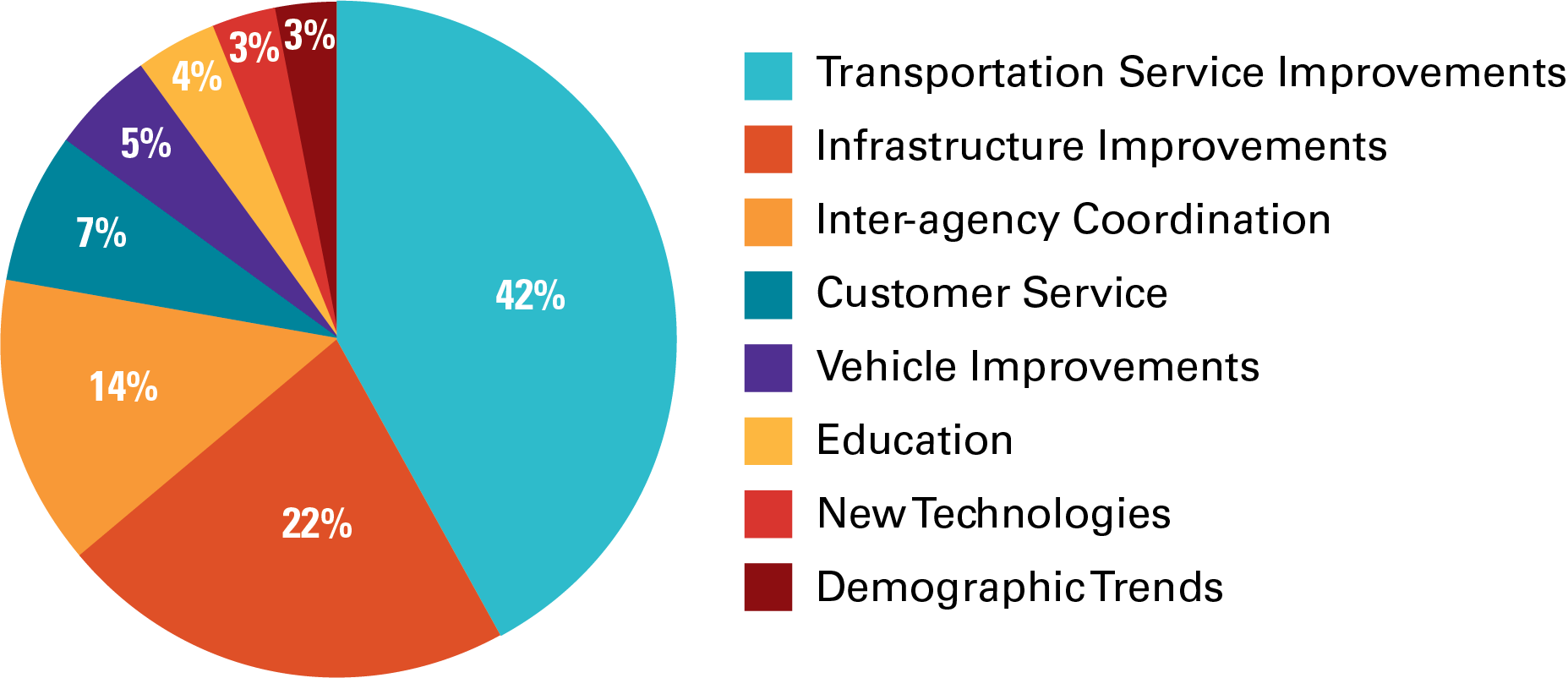
Source: Boston Region MPO.
Table ES-1 summarizes the unmet transportation needs and the potential strategies and actions to meet those needs, as identified through public engagement.
Table ES-1
Summary of Unmet Transportation Needs for Seniors and People with Disabilities and Potential Strategies and Actions to Address the Needs
| Topic Area |
Topic Area Description |
Unmet Transportation Needs |
Potential Strategies and Actions |
|---|---|---|---|
New Technologies |
Input that relates to technologies that are changing, or that may change, how people access and use transportation (such as cell phone apps, automated vehicles, and TNCs) |
|
|
Customer Service |
Input that relates to customer service provided by transportation operators, including driver behavior and communication with passengers |
|
|
Demographic Trends |
Input that relates to demographic trends that may affect transportation service in the future |
|
|
Education |
Input that relates to educational and training opportunities around using public transit |
|
|
Infrastructure Improvements |
Input that relates to maintaining existing or constructing new transportation infrastructure |
|
|
Inter-agency Coordination |
Input that relates to coordination between transportation providers |
|
|
Transportation Service Improvements |
Input that relates to the expansion of public transit services (including new transit routes, frequency, and operating hours) |
|
|
Vehicle Improvements |
Input that relates to the accessibility of vehicles |
|
|
ADA = Americans with Disabilities Act. COA = Councils on Aging. RTA = Regional transit authority. TNC = Transportation network company.
Source: Boston Region MPO.
The priorities listed below could help improve coordination between transportation services for seniors and people with disabilities in a cost-effective manner, while expanding transportation options for seniors and people with disabilities.
Given the size of the Boston region and number and size of different agencies that offer grants and technical assistance, it would be unwieldly to prioritize strategies and actions based on available resources. Rather, Table ES-2 provides a list of some of the state and federal funding that is available from Massachusetts Department of Transportation, the MPO, and the Metropolitan Area Planning Council (MAPC) (the region’s regional planning agencies) that could conceivably support the implementation of the strategies and actions listed in Chapter 4, in addition to the Section 5310 program.
Table ES-2
State Funding Resources
| Agency |
Funding Source |
Description |
Type of Resource |
|---|---|---|---|
MassDOT |
Community Transit Grant Program | Provides funding for capital and operating expenses and mobility management to improve mobility for seniors and people with disabilities. Includes FTA Section 5310 program funding. |
Project implementation |
| Boston Region MPO | Transportation Improvement Program | Provides funding for transportation infrastructure projects. A portion of total available funding is reserved each year for the Community Connections investment program, which will begin accepting applications for the pilot year of funding in fall 2019. Eligible projects include:
|
Project implementation |
Boston Region MPO and MAPC |
Community Transportation Technical Assistance Program |
Provides municipal officials with technical advice on local transportation concerns, including safety, bicycle and pedestrian access, parking, and roadway redesign |
Technical assistance |
Boston Region MPO |
Regional Transit Service Planning Technical Support |
Provides RTAs, TMAs, and municipalities with assistance to address transit issues related to route planning, ridership, cost-effectiveness, and other service characteristics |
Technical assistance |
MAPC |
Corridor/Subarea Planning Studies |
Provides technical assistance to address local parking management and corridor-wide multimodal planning and transit service operations |
Technical assistance |
MAPC |
Alternative-Mode Planning and Coordination |
Provides planning support to advance the use of non-SOV modes, including assistance to areas that are underserved by RTAs and where there are gaps in the transit network |
Technical assistance |
FTA = Federal Transit Administration. MAPC = Metropolitan Area Planning Council. MassDOT = Massachusetts Department of Transportation. MPO = Metropolitan Planning Organization. TMA = Transportation management association. RTA = Regional transit authority. SOV = Single-occupancy vehicle.
Sources: Boston Region MPO, MassDOT, and MAPC.
The Coordinated Plan was produced with input from transit providers, human service and other organizations that serve seniors and people with disabilities, municipalities, and members of the public. The Plan documents the existing transportation services in the Boston region; describes the regions current demographic patterns and forecasts; and identifies the region’s unmet transportation needs, strategies to meet those needs, and priorities for implementation.
Overall, most comments from public engagement relate to improving transportation services, followed by improving transportation infrastructure. While there are many transportation options in the Boston region, a lack of coordination between agencies continues to be a barrier with regards to improved access to desired destinations. The report includes some potential strategies to address these needs and possible implementation priorities. The Boston region’s Coordinated Plan is expected to be updated again in four years in concert with the MPO’s next planned LRTP update, per federal recommendation.
The Boston Region Metropolitan Planning Organization’s (MPO) Coordinated Public Transit–Human Services Transportation Plan (Coordinated Plan) is developed to improve transportation services for seniors and people with disabilities in the Boston region. The primary purpose of the Coordinated Plan is to improve coordination among transit agencies and other transportation providers to better serve the transportation needs of seniors and people with disabilities. It does so by facilitating the coordination of transportation resources and setting regional priorities for transportation investments and initiatives for human services and public transit coordination. It also supports applications to the Federal Transit Administration’s (FTA) Enhanced Mobility of Seniors and Individuals with Disabilities Program (Section 5310 program). This chapter describes the regulatory background of the Coordinated Plan. It also describes in more detail the purpose of the plan, the process of developing the plan, guidance to applicants for using this plan to develop their applications, and the plan’s content.
Signed into law in 2005, the Safe, Accountable, Flexible, Efficient Transportation Equity Act: A Legacy for Users (SAFETEA-LU) was the first federal surface transportation funding legislation to establish the requirement for a locally developed Coordinated Plan to support several FTA formula grant programs. SAFETEA-LU required projects proposed in applications for funding from FTA human-service transportation programs to be included in a Coordinated Plan. These programs included: (1) Enhanced Mobility for Seniors and Individuals with Disabilities; (2) Job Access and Reverse Commute (JARC, Section 5316 program); and (3) New Freedom (Section 5317 program).
Since this initial legislation, the programs for which the Coordinated Plan is required in order for grant applicants to receive funding have changed. Moving Ahead for Progress in the 21st Century, also known as MAP-21, signed into law on July 6, 2012, eliminated JARC and merged the activities in the New Freedom Program with the Section 5310 program. On June 6, 2015, FTA issued its most recent guidance on the administration of the Section 5310 program: Circular (C) 9070.1G, Enhanced Mobility of Seniors and Individuals with Disabilities Program Guidance and Application Instructions. This guidance continues to be in force under the current federal surface transportation legislation, Fixing America’s Surface Transportation Act, also known as the FAST Act. Among other things, C 9070.1G states that to be eligible for funding, projects must be included in a locally developed Coordinated Plan.
In general, Coordinated Plans are intended to improve the coordination and reduce duplication of transportation services for seniors and people with disabilities. They document unmet transportation needs and service gaps for seniors and people with disabilities; current transportation services in the region; potential strategies and actions for improving mobility for seniors and people with disabilities; and priorities for their implementation. Projects proposed for Section 5310 program funding must be included in a locally developed Coordinated Plan.
In Massachusetts, the Department of Transportation (MassDOT) manages the application process for the Section 5310 program under a consolidated competitive grant program called the Community Transit Grant Program (CTGP). Massachusetts regional planning agencies (RPA) are responsible for developing the Coordinated Plan for their region. As the MPO for the Boston area RPA, the Boston Region MPO develops the Coordinated Plan for the 97 municipalities within its region. Figure 1-1, below, shows the municipalities within the MPO region.4
Figure 1-1
Municipalities in the Boston Region MPO

Source: Boston Region MPO.
In keeping with FTA guidance, this Coordinated Plan was developed through a process that included input from seniors, people with disabilities, representatives of transportation providers, and other members of the public and was updated in conjunction with the MPO’s most recent Long-Range Transportation Plan (LRTP), Destination 2040. Public input gathered during the development of the LRTP was also used to inform this update of the Coordinated Plan.
As described above, to be considered for Section 5310 program funding, projects must be included in the Coordinated Plan. FTA maintains flexibility with regards to what it means for a project to be included in a Coordinated Plan. Given the large and diverse nature of the Boston region, the transportation needs and strategies described in this Coordinated Plan are broad in order to elicit a range of project proposals that are tailored by applicants to meet the local conditions of their service area and the interests of their ridership. All Section 5310 program applications must address a need or strategy identified in Chapter 4. This 2019 update to the Boston region’s Coordinated Plan replaces the MPO’s 2015 Coordinated Plan and should be referred to in CTGP applications beginning with the state fiscal year 2021 application cycle.
In keeping with FTA guidance, this Coordinated Plan includes the following components:
Chapter 2 lists the public transit services available in the Boston region. Chapter 3 describes the demographics of the Boston region. Chapter 4 identifies the unmet transportation needs of seniors and people with disabilities as identified through public engagement, potential strategies and actions to meet those needs, and possible priorities for implementation. Finally, Chapter 5 provides a conclusion.
This chapter describes the transportation services that operate in the Boston region, including those provided by the Massachusetts Bay Transportation Authority (MBTA), Regional Transit Authorities (RTA), Transportation Management Associations (TMA), and municipal and nonprofit providers. A map of the MBTA, RTA, and TMA transit systems is provided in Appendix A. An understanding of existing transit services provided important background information for identifying unmet transportation needs when conducting public engagement throughout the region.
The MBTA is the primary transit provider in the Boston region. It directly operates or hires contractors to operate heavy rail, rapid transit, light rail, bus rapid transit, local and express bus, trackless trolley, commuter ferry, and paratransit services. The MBTA’s fixed-route system is a predominantly hub-and-spoke network that serves 175 municipalities. The commuter rail network extends beyond the MPO’s boundary, while bus service extends from Boston to just beyond Interstate 95 and rapid transit, light rail, and bus rapid transit services are mostly limited to municipalities east of Interstate 95. Commuter boat services link two locations in Boston and link to two municipalities on the South Shore.
The MBTA rail rapid transit system serves 140 stations on four lines: the Red Line (including the Mattapan Trolley), the Orange Line, the Blue Line, and the Green Line.
Several projects are underway or planned to improve accessibility on the Green Line. The consolidation of four B Line stations—St. Paul Station with Boston University West Station and Babcock Station with Pleasant Street Station—will include accessible level boarding. In 2018, the MBTA broke ground on the Green Line Extension (GLX), which will go from Lechmere in Cambridge to College Avenue in Medford and Union Square in Somerville. The GLX will feature seven new stations and provide service to Cambridge, Somerville, and Medford. The extension is expected to be completed in 2021. In addition, the MBTA will be improving accessibility at many of the currently inaccessible Green Line stations over the next decade.
The Silver Line (SL) consists of five bus rapid transit routes. SL1 serves downtown Boston, the Seaport, and Boston Logan International Airport. SL2 connects South Station and the Seaport. SL3, which opened in 2018, connects South Station to the Airport, East Boston, and Chelsea. SL4 and SL5 both serve downtown Boston, the South End, and Roxbury.
The MBTA has more than 170 bus routes and four electric trackless trolley routes that serve 44 municipalities. All MBTA buses are accessible. Close to the urban core, buses provide crosstown service and feeder service to rapid transit stations. Buses operating outside of the urban core provide local service, feeder service to rapid transit and some commuter rail branches, and express service to Boston.
The MBTA’s commuter rail system consists of 12 radial lines. There is also seasonal service to Foxborough for special events, to Wachusett Mountain via the Fitchburg Line in the winter, and weekend service to Hyannis on the Middleborough/Lakeville Line during the summer. There are 141 commuter rail stations, 32 of which are not accessible. The commuter rail system directly serves 81 municipalities in Massachusetts and Rhode Island.
The MBTA operates two ferry routes: one between the Charlestown Navy Yard and Long Wharf in downtown Boston, and one between downtown Boston and Hingham. The latter offers two services: one connecting Long Wharf, the Airport, Hull, and Hewitt’s Cove in Hingham, and the other connecting Rowes Wharf in downtown Boston and Hewitt’s Cove.
The RIDE is MBTA’s door-to-door, shared-ride, paratransit service for people who have a disability that prevents them from using the agency’s fixed-route services. The RIDE is an advance-request service that operates vans and sedans in 58 municipalities, generally between 5:00 AM and 1:00 AM. The MBTA is running on-demand paratransit pilots with Uber, Lyft, and Curb Mobility. The RIDE customers are able to book rides directly from their smartphones.
CATA serves the Cape Ann-area towns of Gloucester and Rockport, and provides additional service to Danvers, Essex, and Ipswich. CATA’s fixed-route service consists of six routes. CATA’s dial-a-ride service provides door-to-door transportation for people 60 years of age and older and adults who have a disability. This service is available in Gloucester and Rockport, and for organized trips outside of the Cape Ann region. CATA service operates entirely within the MPO region.
GATRA operates fixed-route service in Attleboro, Taunton, Duxbury, Foxborough, Franklin, Kingston, Mansfield, Marshfield, Middleborough, Norfolk, North Attleboro, Norton, Plainville, Plymouth, Raynham, Scituate, Seekonk, Wareham, and Wrentham. It also operates shuttle services to MBTA stations in Bellingham, Franklin, Norton, Mansfield, Medway, Middleborough, and Pembroke. The agency operates 34 routes (not including route variations), seven of which connect with commuter rail stations. GATRA also operates routes that link residents of Duxbury, Hanover, Kingston, Marshfield, Pembroke, Plymouth, and Scituate to Boston and South Shore-area hospitals. GATRA provides dial-a-ride service for people with disabilities, and for seniors ages 60 years and older.
MWRTA operates 15 fixed-route services (12 of which serve the Worcester Commuter Rail Line and two of which serve the Green Line Monday through Friday), seven commuter shuttles, and one hospital shuttle. It also provides demand response services for seniors and people with disabilities, which includes Americans with Disabilities Act (ADA) paratransit service, where mandated, for those who cannot independently access the fixed-route services. MWRTA serves the municipalities of Ashland, Dover, Framingham, Holliston, Hopedale, Hopkinton, Hudson, Marlborough, Milford, Natick, Sherborn, Southborough, Sudbury, Wayland, Wellesley, and Weston. MWRTA also partners with Councils on Aging (COA) within its member communities to provide additional services.
MART provides public transportation to 22 municipalities in north-central Massachusetts; included in those municipalities are Stow, Bolton, Boxborough, and Littleton, which are also within the MPO region. It operates 12 local bus routes, five regional bus routes, and shuttles that provide connections to commuter rail, Fitchburg State University, and Lunenburg Town Hall. ADA-eligible paratransit service is available in the same area served by fixed-route service. MART also provides COA services in all of its member communities except Royalston.
BAT provides service to the South Shore and Greater Brockton area. Of the 10 municipalities that are served by BAT, two are in the MPO region (Canton and Rockland). BAT also runs a fixed-route bus service from Brockton to Ashmont Station on the Red Line.
LRTA serves 14 municipalities, three of which are in the MPO region—Acton, Maynard, and Carlisle. Service is also provided to the Burlington Mall and Lahey Clinic in Burlington and the Wilmington Commuter Rail Station. LRTA also provides curb-to-curb ADA paratransit service to people with disabilities who are unable to use the fixed-route bus service, as well as a curb-to-curb service to seniors within the LRTA service area who are 60 years of age or older.
MVRTA serves 14 municipalities; the only one in the Boston region is North Reading, which receives MVRTA’s Ring & Ride service. Ring & Ride is for North Reading residents who are 60 years of age or older or disabled veterans of any age for door-to-door medical appointments. MVRTA also provides medical transportation on Mondays, Tuesdays, and Thursday to several Boston area hospitals. In addition, MVRTA runs two commuter services to Boston: one from North Andover, and one from Methuen, Lawrence, and Andover.
Massport operates several transit services to the port and airport facilities that the agency operates. Within the Boston region, these include the following services:
A TMA is a membership-based coalition of businesses, universities and other institutions, and municipalities that work together to provide transportation solutions for commuters. The transit services listed below are funded by each TMA, and provide transportation for employees of the TMA membership and sometimes for members of the public.
The Alewife TMA serves the area around Alewife Station in Cambridge. The TMA operates the Alewife Station Loop Shuttle, which connects area business with Alewife Station, and the Burlington-to-Alewife Shuttle, which connects Burlington, Billerica, Woburn, and Lowell to Alewife Station.
The Charles River TMA serves Cambridge-area residents and businesses. The TMA operates the EZRide Shuttle, which connects the Cambridgeport and Kendall Square neighborhoods in Cambridge with the Lechmere, Science Park, and North Stations on the Green Line.
CrossTown Connect (CTC) serves the municipalities of Westford, Littleton, Acton, Boxborough, Concord, Maynard, Sudbury, and Westford. CTC provides the following transit services:
MASCO serves medical and science-related businesses and their employees in the Longwood Medical Area (LMA) of Boston. MASCO operates eight shuttles that serve employees who work in the LMA. Most require passengers to be employees of MASCO member institutions. Three are park-and-ride shuttles (Chestnut Hill Lot, The Fenway, and Wentworth Lot), three connect to transit stations (JFK/UMass Station, Midday Wentworth-Ruggles-JFK combo, and Ruggles Station), and two operate between employers (Harvard Chan-Landmark and M2 Cambridge-HMS).
The MetroWest/495 TMA serves employers and residents of the Framingham region. The TMA operates the MetroWest Express, which connects the Back Bay neighborhood of Boston with Framingham-area employers.
Middlesex 3 TMA serves nine municipalities; Lexington, Bedford, and Burlington are within the Boston MPO region. Two shuttles provide reverse-commute commuter service to rapid transit stations. One service connects Alewife Station with Burlington, and the other service connects Haymarket Station and Alewife Station to several employers in Bedford and Billerica.
The Neponset Valley TMA serves the municipalities of Canton, Dedham, Foxborough, Norwood, and Westwood. It operates the following services:
The North Shore TMA covers Beverly, Danvers, Lynn, Peabody, and Salem. It operates the North Shore Wave shuttle that connects the MBTA commuter rail station at Beverly Depot to businesses at Cummings Center, Trask Lane, and Cherry Hill Drive.
The Route 128 Business Council provides employee shuttles for member businesses. They serve municipalities along the Route 128 corridor. Seven shuttles connect businesses with the Alewife Station on the Red Line, two shuttles connect residents with Waltham Center, and one shuttle connects Needham Crossing to the Newton Highlands Station on the Green Line.
TranSComm shuttles serve patients, students, and employees at the Boston University Medical Campus. It operates one shuttle that serves patients (HealthNet Shuttles) and two shuttles that serve employees and students (Evening Transit “T” Shuttle and Boston Veterans Administration Shuttle).
Some nonprofit organizations and local private institutions, such as universities and hospitals, also operate transit services in the region. They typically operate shuttles specifically for their employees and/or patients or students between their various campuses and/or nearby neighborhoods. Smaller services also provide local transportation for seniors or people with disabilities. Private for-profit senior care companies and taxi companies may also provide transportation around the region. While these are too numerous to list here, massridematch.org provides information about these and other transportation providers.
Many private, for-profit transit operators serve the Boston region. The following carriers make stops in the Boston region:
Locally, many municipalities offer transportation services for seniors and/or people with disabilities. Municipal COAs provide support services to seniors, families, and caregivers, and some offer transportation services for these populations. An online COA directory provides a list of COAs by location. Some municipalities also offer local transportation for all residents, such as Lexington’s Lexpress bus.
Some COAs and nonprofit human service organizations also operate volunteer driver programs, such as those listed below:
This chapter provides information about seniors and people with disabilities in the Boston region. The data show the share of these populations in the region using the most recent data from the US Census Bureau as well as demographic projections for 2040. An understanding of current and changing demographics about these populations provided important background information for identifying unmet transportation needs when conducting public engagement throughout the region.
Federal Transit Administration (FTA) guidance defines a senior as an individual who is 65 years old or older. In the Boston region, 13.4 percent of the population falls within this definition of a senior. Figure 3-1 shows the population ages 65 years old and older, by municipality. As of 2010, Boxborough has the fewest number of seniors, with 421 individuals, while Boston has the most, with 62,237 individuals. Figure 3-2 shows the share of the population in each municipality who are seniors, ranging from 7.9 percent in Hopkinton to 23.1 percent in Rockport.5
Figure 3-1
Population Ages 65 and Older, by Municipality

Figure 3-2
Share of the Population Ages 65 and Older, by Municipality
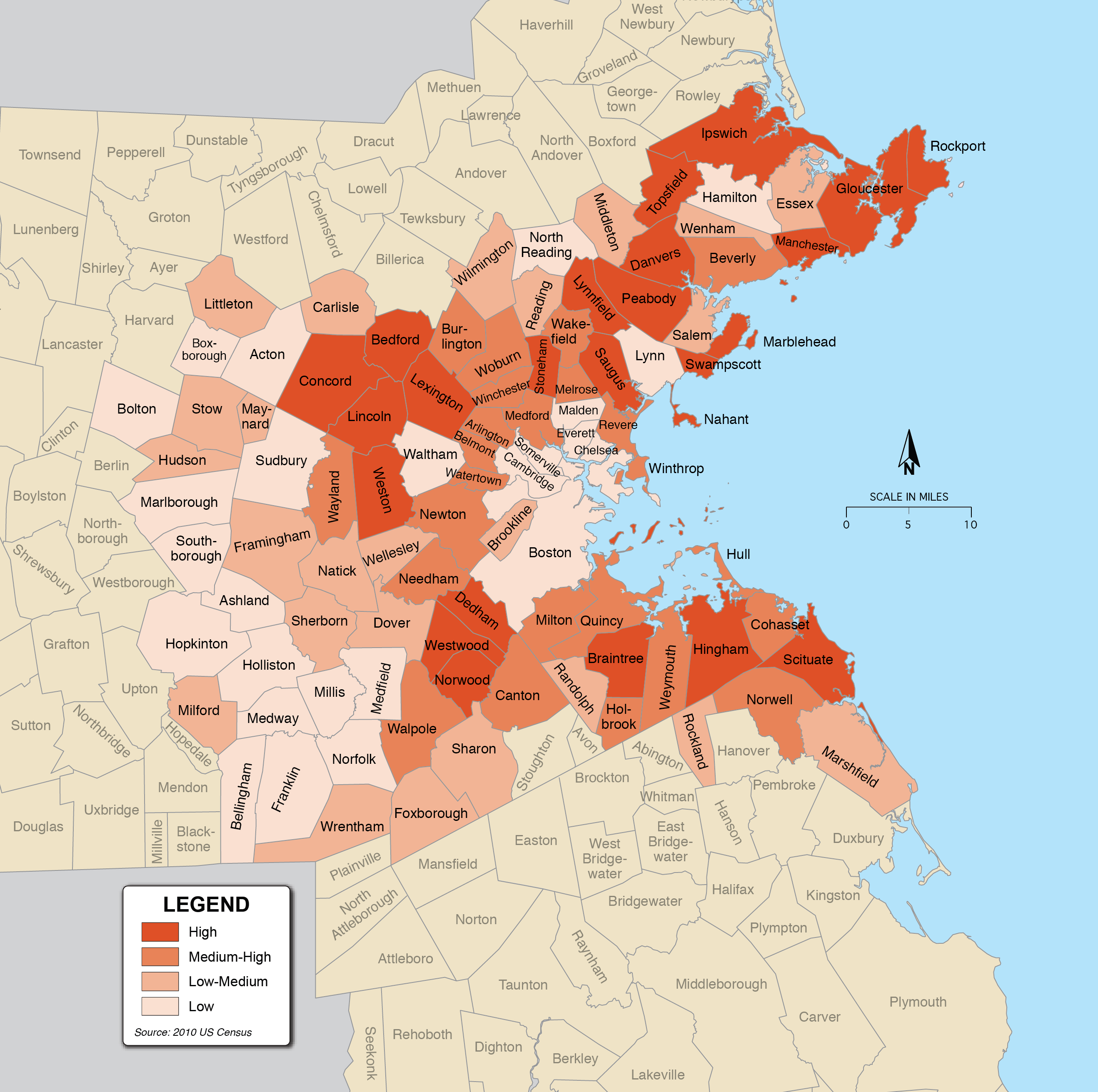
In the Boston region, a total of 459,866, or 10.4 percent of the population, reported having a disability on the 2013–17 American Community Survey (ACS).6 Figure 3-3 shows the number of people in each municipality that report having a disability. According to the 2013–17 ACS, this ranges from 246 individuals in Sherborn to 81,362 individuals in Boston. Boxborough has the lowest share of people with disabilities, with five percent, while Holbrook has the highest share, with 16.7 percent. Figure 3-4 shows the share of the population in each municipality that has a disability.
Figure 3-3
Population with Disabilities, by Municipality
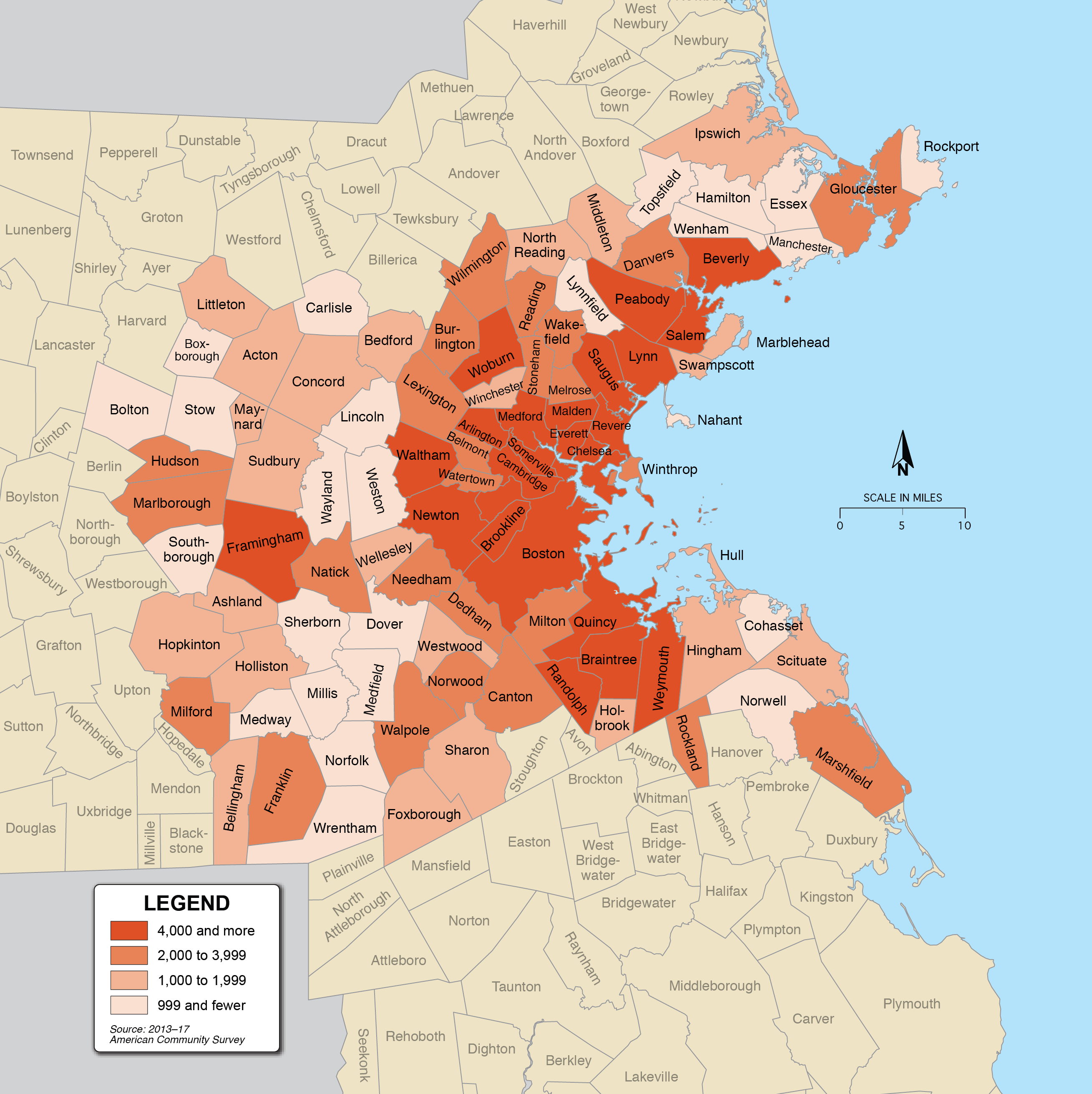
Figure 3-4
Share of the Population with Disabilities, by Municipality
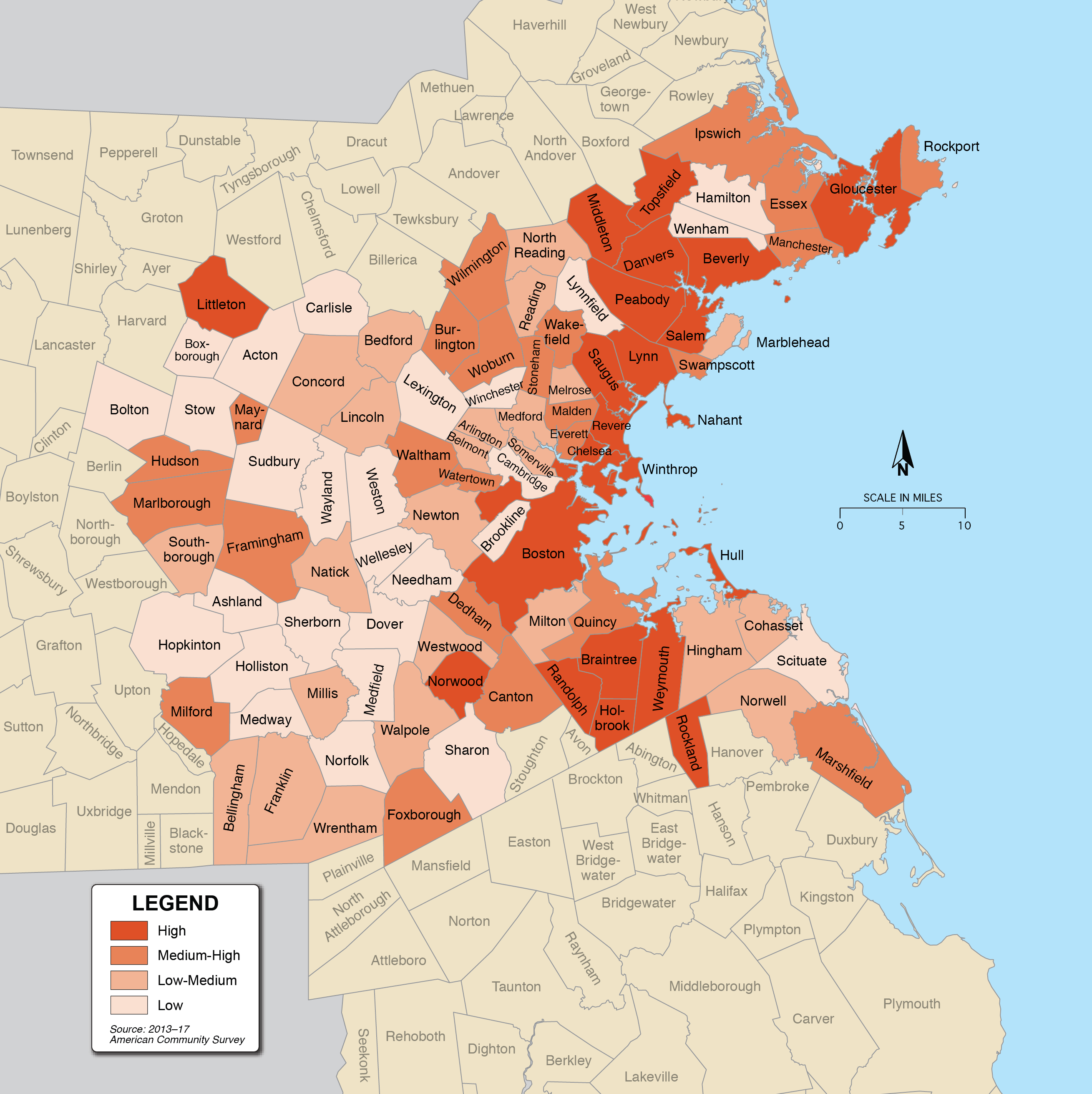
Seniors in the Boston region are more likely than the rest of the population to have a disability. About one-third of seniors have a disability, compared to the 7.6 percent of people between the ages of 18 and 64 and the 3.9 percent of people under age 18 who have disabilities. Table 3-1 shows the MPO population with disabilities broken out by age cohort.
Table 3-1
Boston Region MPO Population with Disabilities by Age Cohort
Age Cohort |
Total Populationa |
Population with Disabilities |
Percent of Age Cohort Population with Disabilities |
Younger than Age 18 |
641,335 |
24,696 |
3.9% |
18 to 64 Years |
2,118,790 |
161,488 |
7.6% |
65 Years and Older |
459,866 |
148,743 |
32.3% |
TOTAL |
3,219,991 |
334,927 |
N/A |
a Disability status is determined only for the noninstitutionalized population.
MPO = Metropolitan Planning Organization. N/A = not applicable.
Source: 2013–17 American Community Survey.
Demographic projections completed for Destination 2040 by the Metropolitan Area Planning Council (MAPC) and the University of Massachusetts Donahue Institute show that the share of the population 75 years of age and older is projected to increase between 2010 and 2040. 7 Figure 3-5 shows the current and projected age cohort breakdowns of the population living in households in 2010 and 2040.8 All three age cohorts are projected to increase in total population size; however, the share of the population 75 years of age and older is projected to increase the most, from 6.4 percent to 11.3 percent of the population in the Boston region.
Figure 3-5
Population Projections by Age Cohort, 2010 and 2040

Source: Data from the University of Massachusetts Donahue Institute and the Metropolitan Area Planning Council.
Demographic projections are not available for people with disabilities. However, as Table 3-1 shows, approximately one-third of seniors have a disability. With a projected increase in the share of the population in this age cohort, the share of the population with disabilities may increase as well. These data suggest that transportation providers in the Boston region will increasingly have to plan for the transportation needs of seniors and people with disabilities as they make up an increasing share of the region’s population. These patterns are likely to shape the demand for transportation by increasing the need for transportation that serves seniors and people with disabilities into the foreseeable future.
Chapters 2 and 3 provide the background information necessary to understand existing and likely future conditions of mobility for seniors and people with disabilities in the Boston region. To fully identify unmet transportation needs and suitable solutions to address them, Metropolitan Planning Organization (MPO) staff conducted a public engagement process based on this understanding of existing conditions and projected demographic changes. This chapter describes the public engagement activities conducted and the key findings that led to the identification of unmet needs, strategies, and priorities for mobility improvements for seniors and people with disabilities in the Boston region.
Projects eligible for the Section 5310 program include both traditional capital projects and nontraditional projects. Federal Transit Administration (FTA) defines eligible traditional capital projects as those planned, designed, and carried out to meet the special transportation needs of seniors and people with disabilities when public transit is insufficient, inappropriate, or unavailable. FTA defines eligible nontraditional projects as those that exceed transportation services required under the Americans with Disabilities Act (ADA); improve access to fixed-route service and decrease reliance on ADA-complementary paratransit service by people with disabilities; or provide alternatives to public transit that assists seniors and people with disabilities with transportation. At least 55 percent of program funds must be used for traditional projects. The remaining 45 percent may be used for nontraditional projects.
FTA guidance provides some examples of eligible traditional and nontraditional projects. These may include one or more of the following projects:
Direct recipients of Section 5310 program funding must be states or local government authorities while private, nonprofit organizations and other entities that operate public transit services are allowed to be subrecipients.
The goals of the public engagement activities were to hear directly from seniors and people with disabilities, nonprofit human service organizations, and providers of transportation about the transportation needs of seniors and people with disabilities and to identify potential strategies and actions to address these needs.
Public engagement for this plan consisted of two phases. The first phase was coordinated with the 2019 Long-Range Transportation Plan (LRTP), Destination 2040, outreach activities, the purpose of which was to gather input on the transportation needs and priorities in the region.9 As part of this public engagement process, MPO staff partnered with organizations that work with traditionally underserved populations, including seniors and people with disabilities. Outreach included both in-person events and online surveys.
After completing this first phase, MPO staff assessed the input received and determined that more input from seniors and people with disabilities was needed for the Coordinated Plan, especially input about potential strategies and actions to address unmet transportation needs for those groups. In the second phase of public engagement, staff conducted two types of outreach: in-person events and an online survey. Although this second phase was similar to phase one, it focused more on getting input only from seniors and people with disabilities and people who work at human service agencies or transportation providers. Questions were written to collect more detailed responses about the transportation needs, strategies, and actions that are at the core of the Coordinated Plan.
The following sections describe the two main outreach approaches—in-person events and online engagement—conducted during the two phases of public engagement.
In phase one, in-person public outreach events involved collaborating with local organizations and municipalities to get their input and input from the people they serve. Some events held as part of the LRTP’s public engagement process involved partners that had a broad interest in transportation beyond just mobility for seniors and people with disabilities.
Examples of events held during phase one include meetings with subregional councils that are coordinated by the Metropolitan Area Planning Council (MAPC) that bring interested parties together to discuss planning issues in their subregion.10 At other events, the MPO partnered with human service organizations who work directly with seniors and people with disabilities. These organizations included the Boston Disability Commission; the Neponset Valley Transportation Management Association (TMA); the Boston North Regional Coordinating Council; LivableStreets; and Transportation Resources, Information, Planning and Partnership for Seniors. At all of these events, staff specifically asked about transportation needs, and strategies to address those needs, for seniors and people with disabilities.
In phase two of public engagement, staff collaborated with Regional Coordinating Councils (RCC) in the Boston region to get input from their members.11 Engaging with RCCs was critical for receiving input from representatives from a cross section of organizations that serve seniors and/or people with disabilities. Staff visited four RCCs in the MPO region: Neponset Valley RCC (in a joint meeting with the Neponset Valley Suburban Mobility Working Group–Health and Human Services Subcommittee); the Boston North RCC; the Boston Area RCC; and the Minuteman RCC (in a joint meeting with CrossTown Connect).
During phase one of online engagement, follow-up surveys were sent to organizations with which MPO staff had partnered on in-person events to get input from their constituents and members who may not have had a chance to participate in the in-person meetings. The surveys specifically asked about the transportation needs of traditionally underserved populations in the MPO’s region, including seniors and people with disabilities (see Appendix B).
During the second phase of online engagement, MPO staff sent a survey that asked open-ended questions about transportation needs and potential strategies and actions to meet these needs (see Appendix B). The survey was distributed broadly through the MPO’s email channels, Twitter, and partner organizations that distributed it to their contacts.12 This second survey helped MPO staff reach the goal of reaching seniors and people with disabilities; 45 percent of respondents identified as such. Staff also received significantly more input on potential strategies and actions to meet transportation needs.
MPO staff received 444 comments from the Coordinated Plan survey (from 132 completed surveys) and 124 comments from the Destination 2040 survey. Further, staff gathered 191 comments related to the transportation needs and strategies of seniors and people with disabilities at in-person meetings in phase one and 155 comments at in-person meetings in phase two.
Figure 4-1 shows the affiliation of respondents to the survey conducted during the second phase.13 As noted above, 45 percent of respondents to the phase two surveys were from members of the public. A further 27 were from a municipal government.
Figure 4-1
Respondent Affiliation for the Survey Conducted in the Second Phase
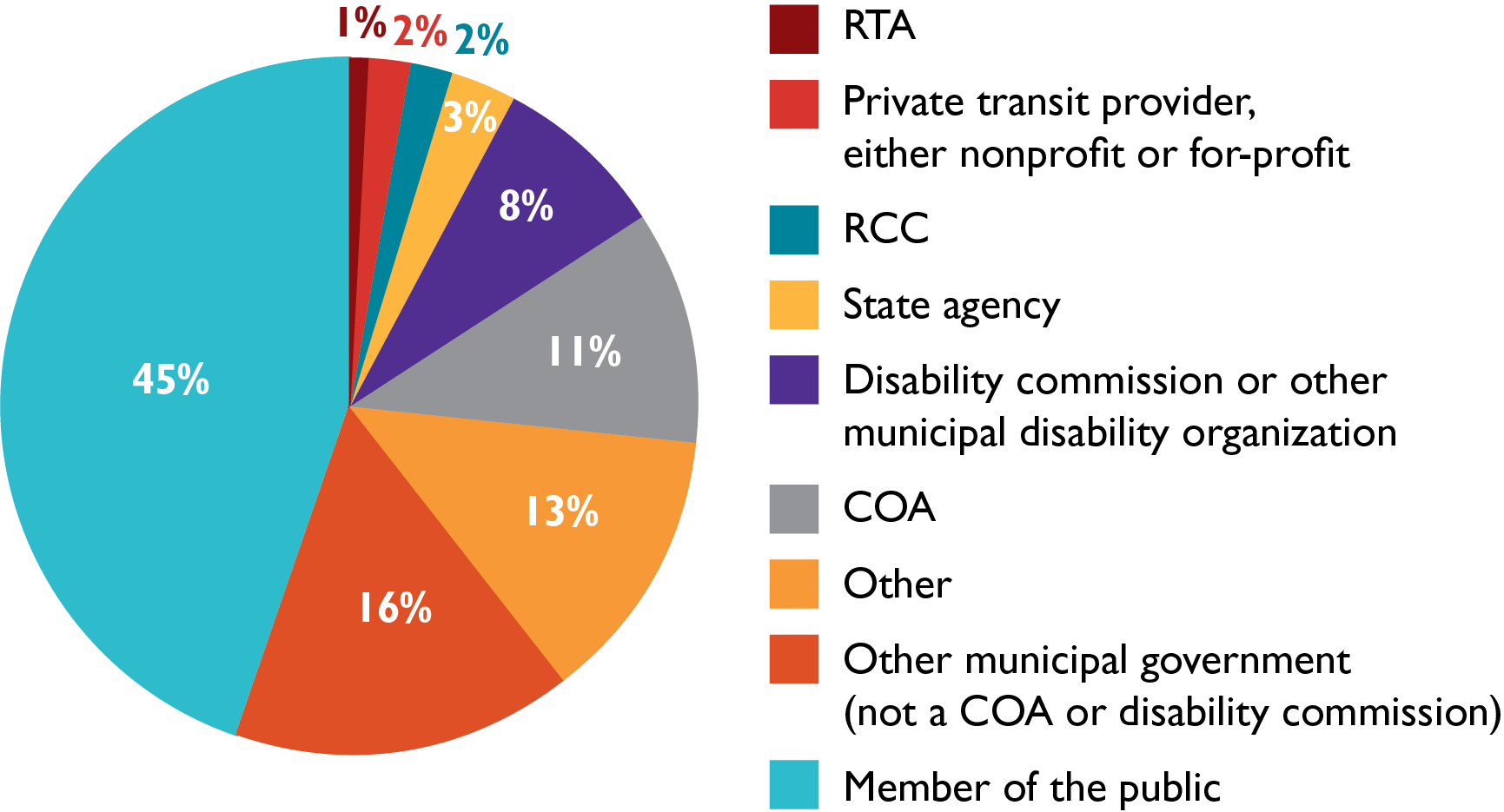
COA = Councils on Aging. RCC = Regional Coordinating Council. RTA = Regional Transit Authority.
Source: Boston Region MPO.
Survey respondents were also asked about their background. Thirty percent responded that they have a disability, which is significantly higher than the 10 percent MPO region average. Fifty-five percent said that they were 65 years old or older, which is also higher than the MPO region average of 6.7 percent.
Further, 7.6 percent said they identified as a race other than White and one percent identified as Hispanic or Latino/a/x. Seventeen percent said their annual income was less than $45,000 (which is the MPO’s threshold for low income).14 Finally, 62 percent of respondents were women and 32 percent of respondents were men (one percent specified “other” and five percent selected “prefer not to answer”).
This section summarizes the transportation needs and potential strategies and actions to address those needs as identified through public engagement. Input from the public was organized into one of the nine topic areas described below, and grouped by whether it identified an unmet transportation need or identified a potential strategy to meet those needs. Both needs and strategies were grouped into the following topic areas:
Figure 4-2 shows the breakdown of comments (relating either to needs or strategies and actions) in each topic area. Forty-two percent of the comments relate to transportation service improvements, the most common topic. The second most common topic area was infrastructure improvements at 22 percent. The least common were the demographic trends and new technologies topic areas at three percent each.
Figure 4-2
Share of Comments by Topic Area

Source: Boston Region MPO.
Table 4-1 summarizes the transportation needs and potential strategies and actions that fall into each topic area identified through public engagement.
Table 4-1
Summary of Unmet Transportation Needs for Seniors and People with Disabilities and Potential Strategies and Actions to Address these Needs
| Topic Area |
Topic Area Description |
Unmet Transportation Needs |
Potential Strategies and Actions |
|---|---|---|---|
New Technologies |
Input that relates to technologies that are changing, or that may change, how people access and use transportation (such as cell phone apps, automated vehicles, and TNCs) |
|
|
Customer Service |
Input that relates to customer service provided by transportation operators, including driver behavior and communication with passengers |
|
|
Demographic Trends |
Input that relates to demographic trends that may affect transportation service in the future |
|
|
Education |
Input that relates to educational and training opportunities around using public transit |
|
|
Infrastructure Improvements |
Input that relates to maintaining existing or constructing new transportation infrastructure |
|
|
Inter-agency Coordination |
Input that relates to coordination between transportation providers |
|
|
Transportation Service Improvements |
Input that relates to the expansion of public transit services (including new transit routes, frequency, and operating hours) |
|
|
Vehicle Improvements |
Input that relates to the accessibility of vehicles |
|
|
ADA = Americans with Disabilities Act. COA = Councils on Aging. RTA = Regional transit authority. TNC = Transportation network company.
Source: Boston Region MPO.
There are many more possible strategies to address transportation needs of seniors and people with disabilities identified in the Coordinated Plan than there are available resources for immediate implementation. Although it is necessary to prioritize strategies and actions based on available resources, this Coordinated Plan does not attempt to dictate which strategies and actions should receive funding. Rather, it describes priorities for the Boston region based on how frequently needs were identified during the public engagement process as a way for transportation providers to plan for and prioritize their services, including those proposed for Section 5310 program funding. The priorities listed below could help improve coordination between transportation services for seniors and people with disabilities in a cost-effective manner, while expanding transportation options for seniors and people with disabilities.
There are many resources in the Boston region that can help transportation providers implement these strategies. Table 4-2 presents a list of some of the state and federal funding that is available from Massachusetts Department of Transportation, the MPO, and MAPC that could conceivably support the implementation of the strategies and actions listed in this chapter, in addition to the Section 5310 program. This is not a comprehensive list, but acts as a resource for transportation providers. Some sources provide funding directly for capital, operating, and/or mobility management costs, while others provide technical assistance for the development of project ideas.
Table 4-2
State Funding Resources
| Agency |
Funding Source |
Description |
Type of Resource |
|---|---|---|---|
MassDOT |
Community Transit Grant Program |
Provides funding for capital and operating expenses and mobility management to improve mobility for seniors and people with disabilities. Includes FTA Section 5310 program funding. |
Project implementation |
Boston Region MPO |
Transportation Improvement Program |
Provides funding for transportation infrastructure projects. A portion of total available funding is reserved each year for the Community Connections investment program, which will begin accepting applications for the pilot year of funding in fall 2019. Eligible projects include:
|
Project implementation |
Boston Region MPO and MAPC |
Community Transportation Technical Assistance Program |
Provides municipal officials with technical advice on local transportation concerns, including safety, bicycle and pedestrian access, parking, and roadway redesign |
Technical assistance |
Boston Region MPO |
Regional Transit Service Planning Technical Support |
Provides RTAs, TMAs, and municipalities with assistance to address transit issues related to route planning, ridership, cost-effectiveness, and other service characteristics |
Technical assistance |
MAPC |
Corridor/Subarea Planning Studies |
Provides technical assistance to address local parking management and corridor-wide multimodal planning and transit service operations |
Technical assistance |
MAPC |
Alternative-Mode Planning and Coordination |
Provides planning support to advance the use of non-SOV modes, including assistance to areas that are underserved by RTAs and where there are gaps in the transit network |
Technical assistance |
FTA = Federal Transit Administration. MAPC = Metropolitan Area Planning Council. MassDOT = Massachusetts Department of Transportation. MPO = Metropolitan Planning Organization. TMA = Transportation management association. RTA = Regional transit authority. SOV = Single-occupancy vehicle.
Sources: Boston Region MPO, MassDOT, and MAPC.
The Coordinated Plan was developed with input received from transit providers, human service organizations, and other organizations that serve seniors and people with disabilities, municipalities, and members of the public. It documents the Boston region’s current public transit and human services transportation; the unmet transportation needs of seniors and people with disabilities; strategies and actions to meet the unmet needs; and priorities for implementation. Overall, most comments from public input relate to improving transportation service, followed by improving transportation infrastructure. In addition, while there are many transportation options in the Boston region, as documented in Chapter 2, a lack of coordination between agencies continues to be a barrier with regards to improved access to desired destinations, especially between suburbs and across transit provider boundaries. Chapter 4 points to some potential strategies to address these needs and possible implementation priorities.
This 2019 update to the Coordinated Plan provides information about the transportation needs of seniors and people with disabilities, as well as strategies to address these needs and to support applications for Federal Transit Administration's Section 5310 program. It updates and replaces the Boston Region MPO’s 2015 Coordinated Plan starting with the state fiscal year 2021 Community Transit Grant Program grant cycle. This document is expected to be updated again in four years in concert with the Metropolitan Planning Organization’s next planned Long-Range Transportation Plan update, per federal recommendation.
Figure A-1
Fixed Route Service and Local Transit
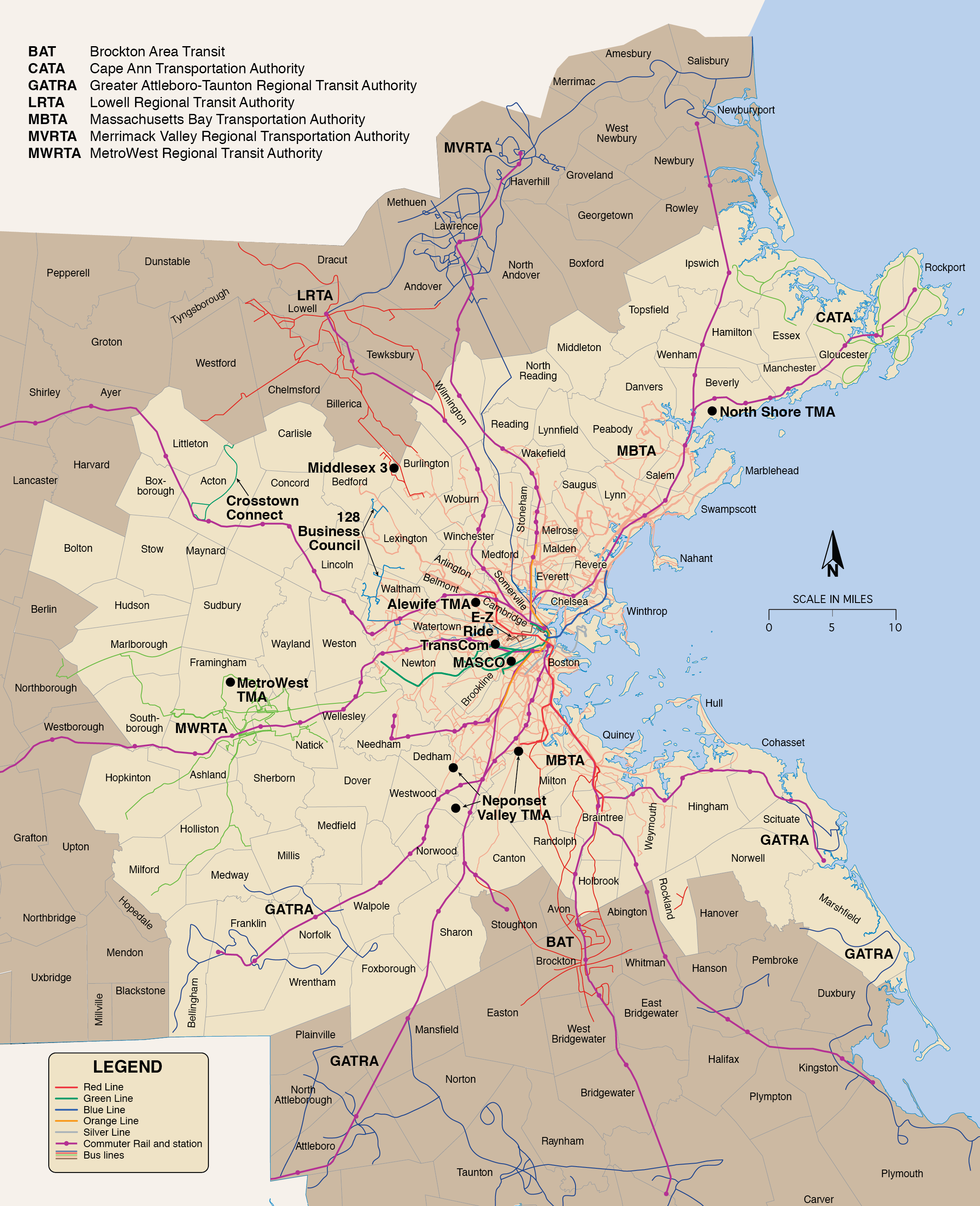
Figure B-1
Coordinated Plan Survey for Phase One
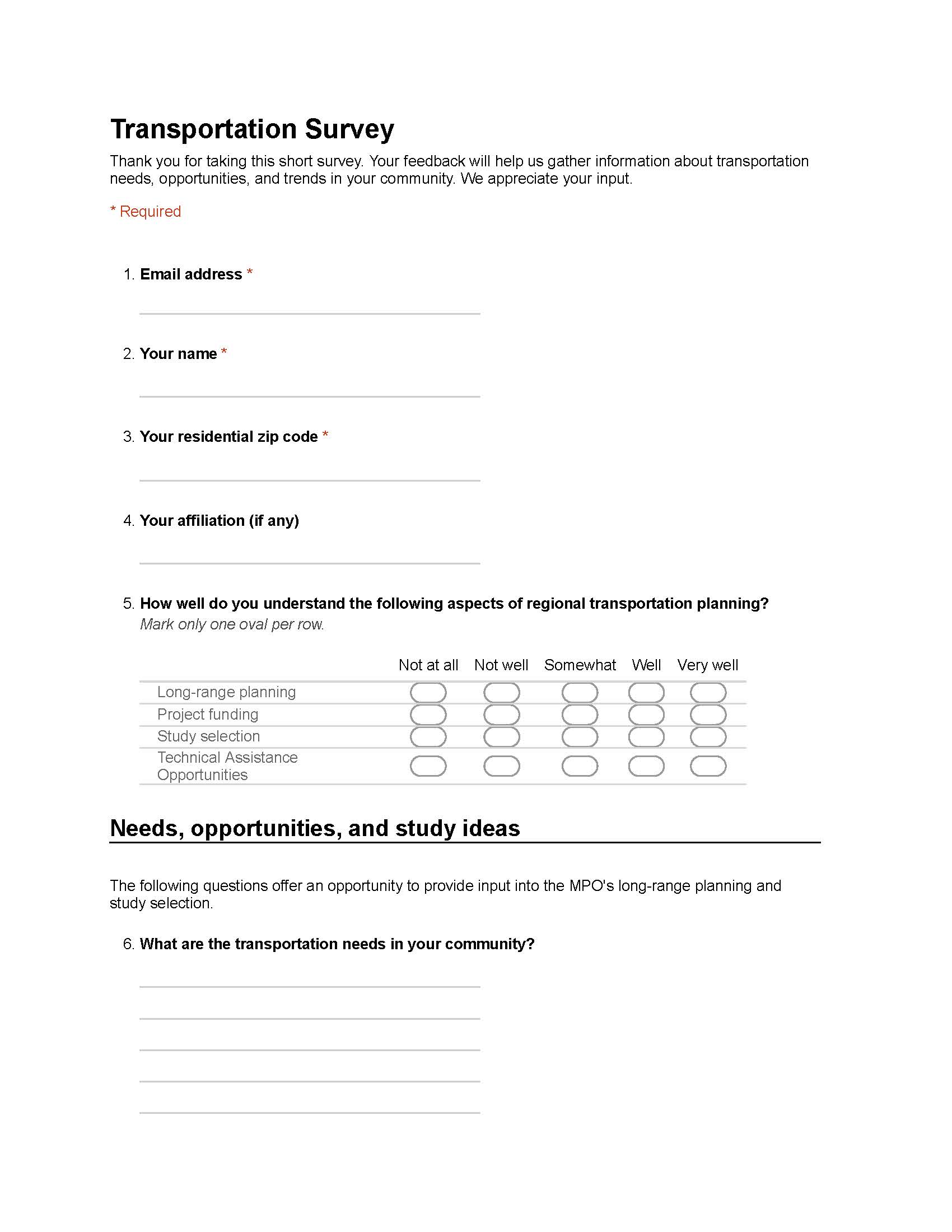

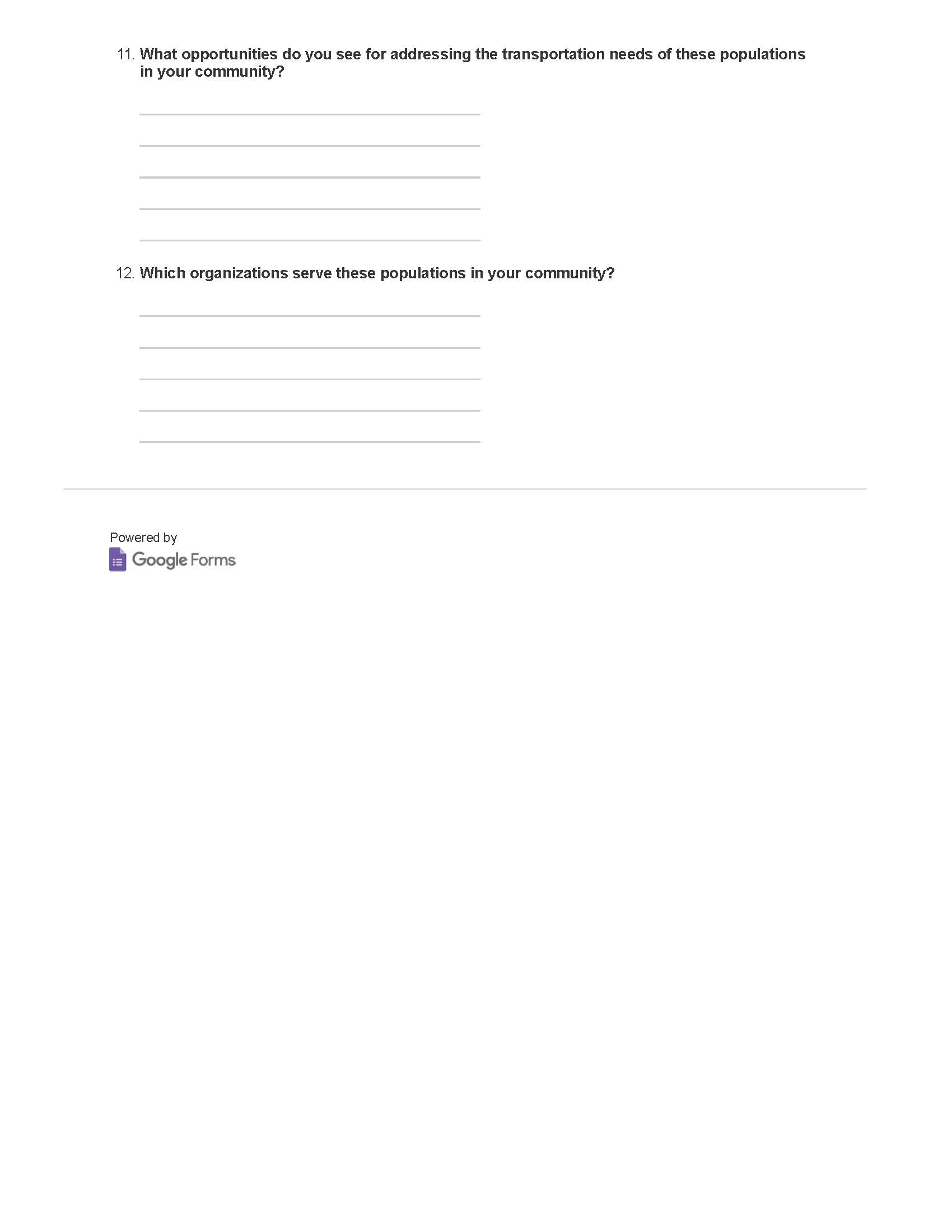
Figure B-2
Coordinated Plan Survey for Phase Two
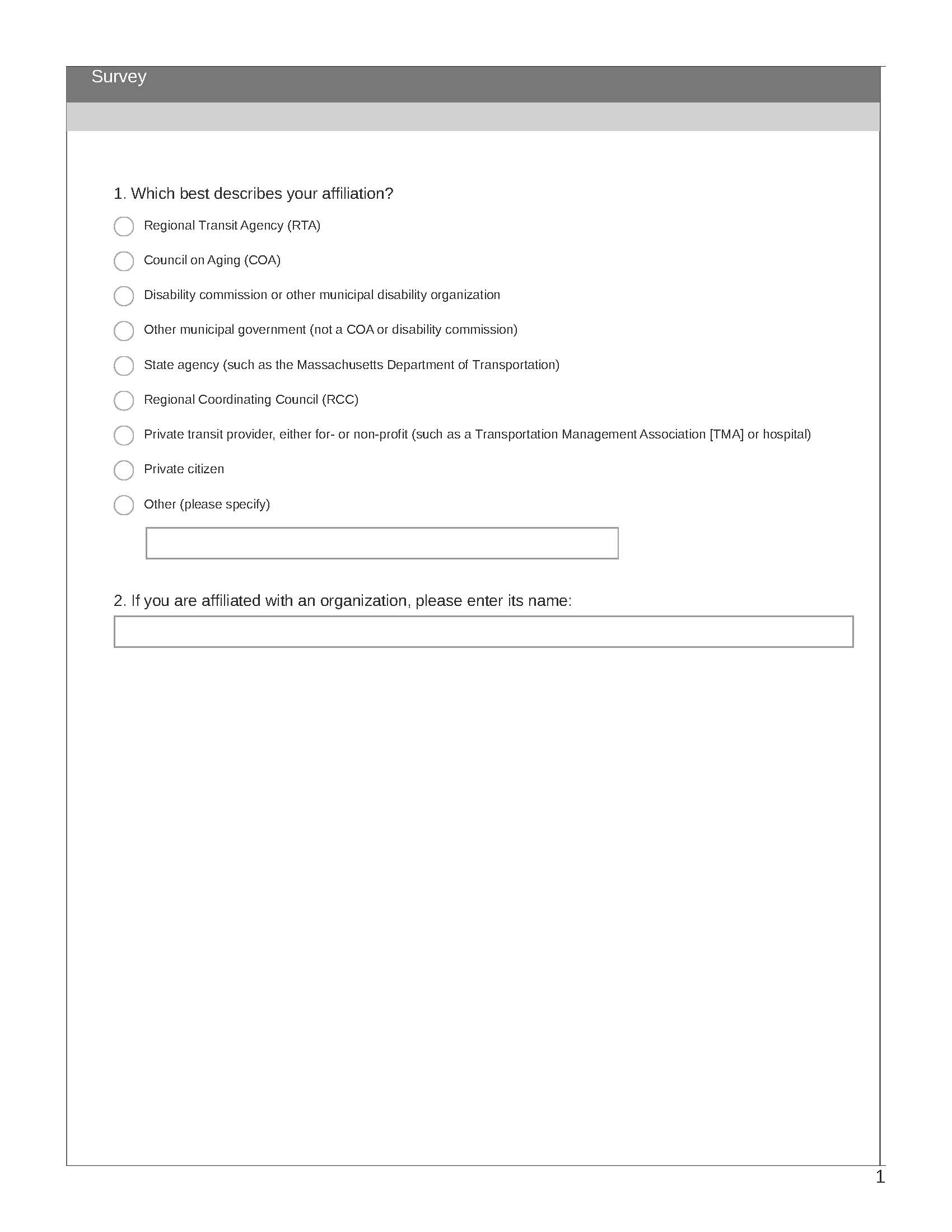
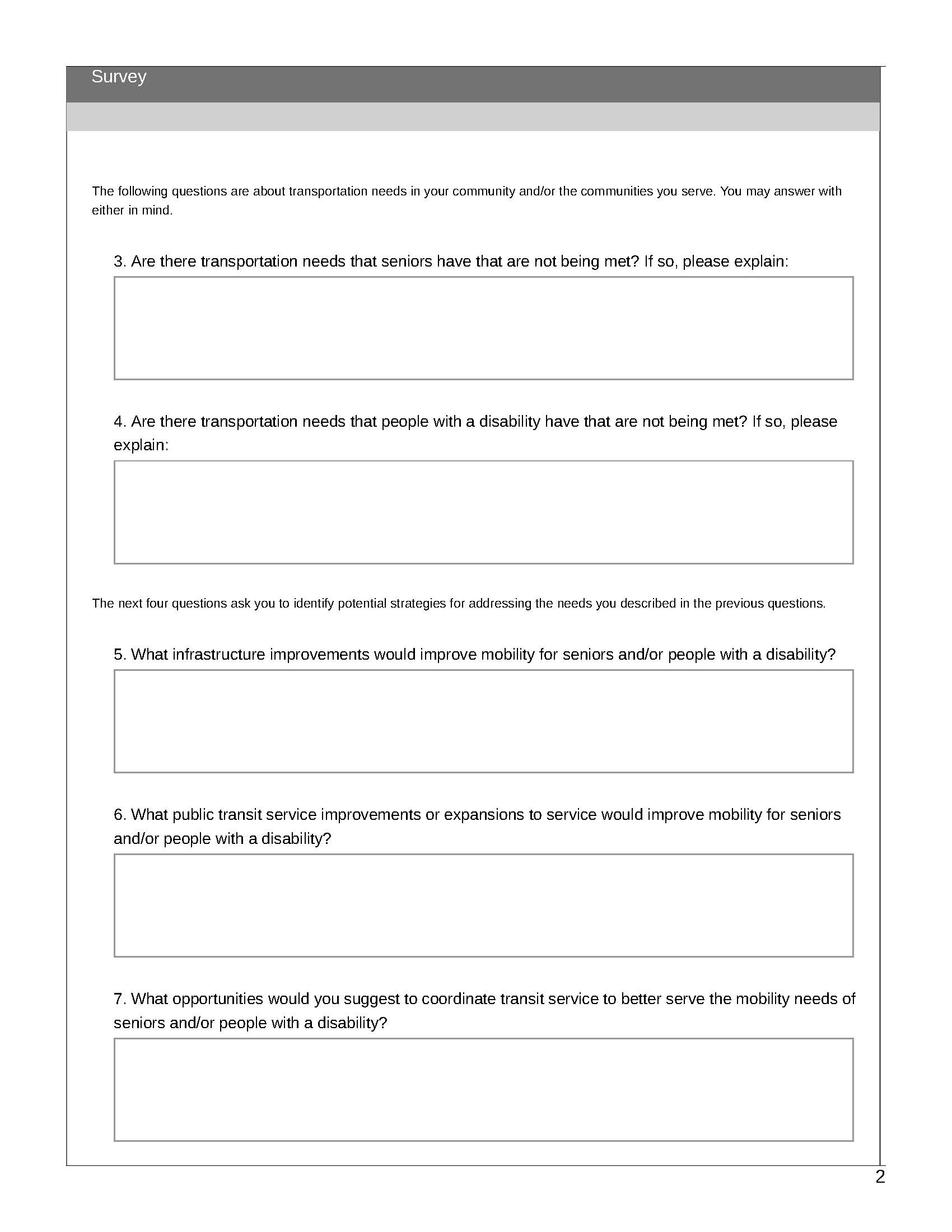
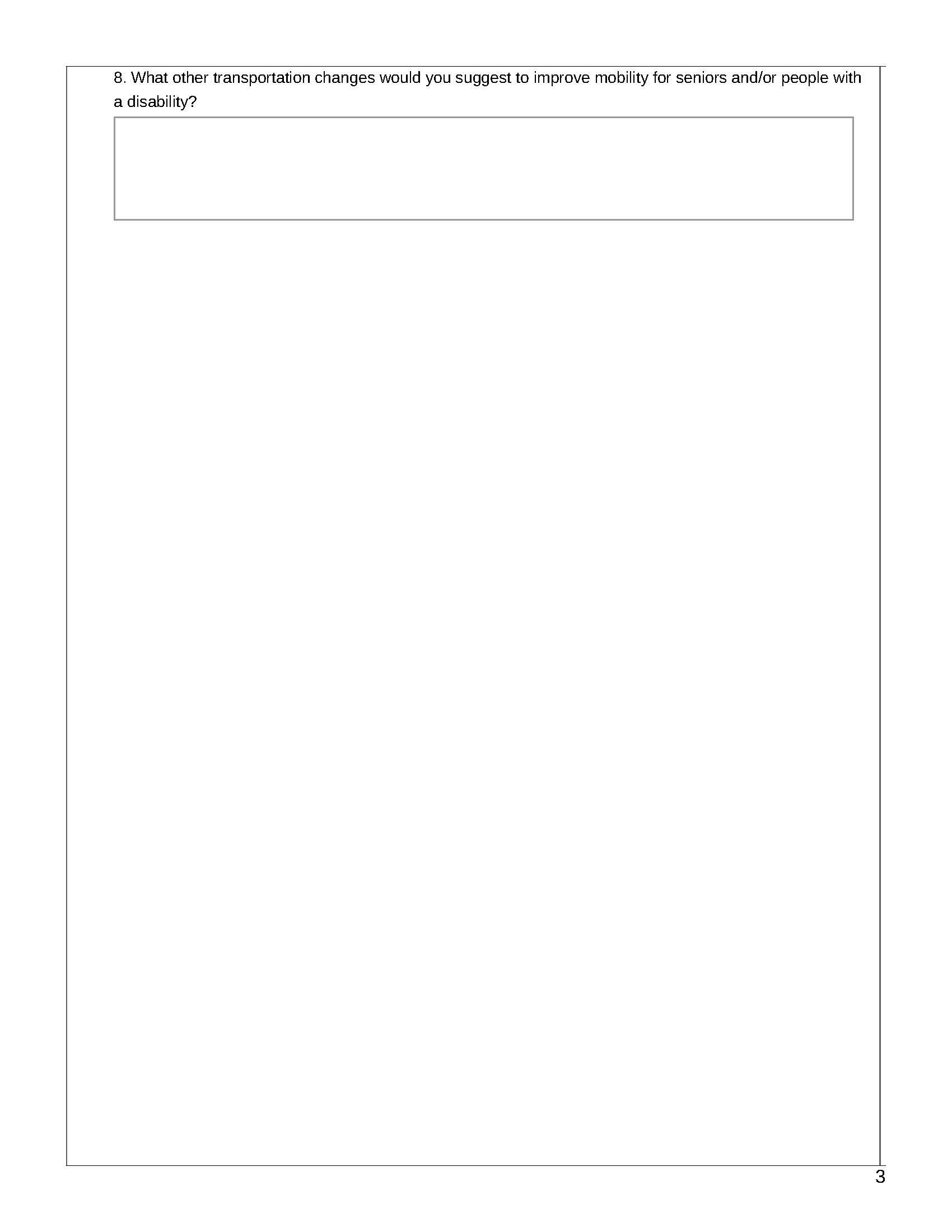
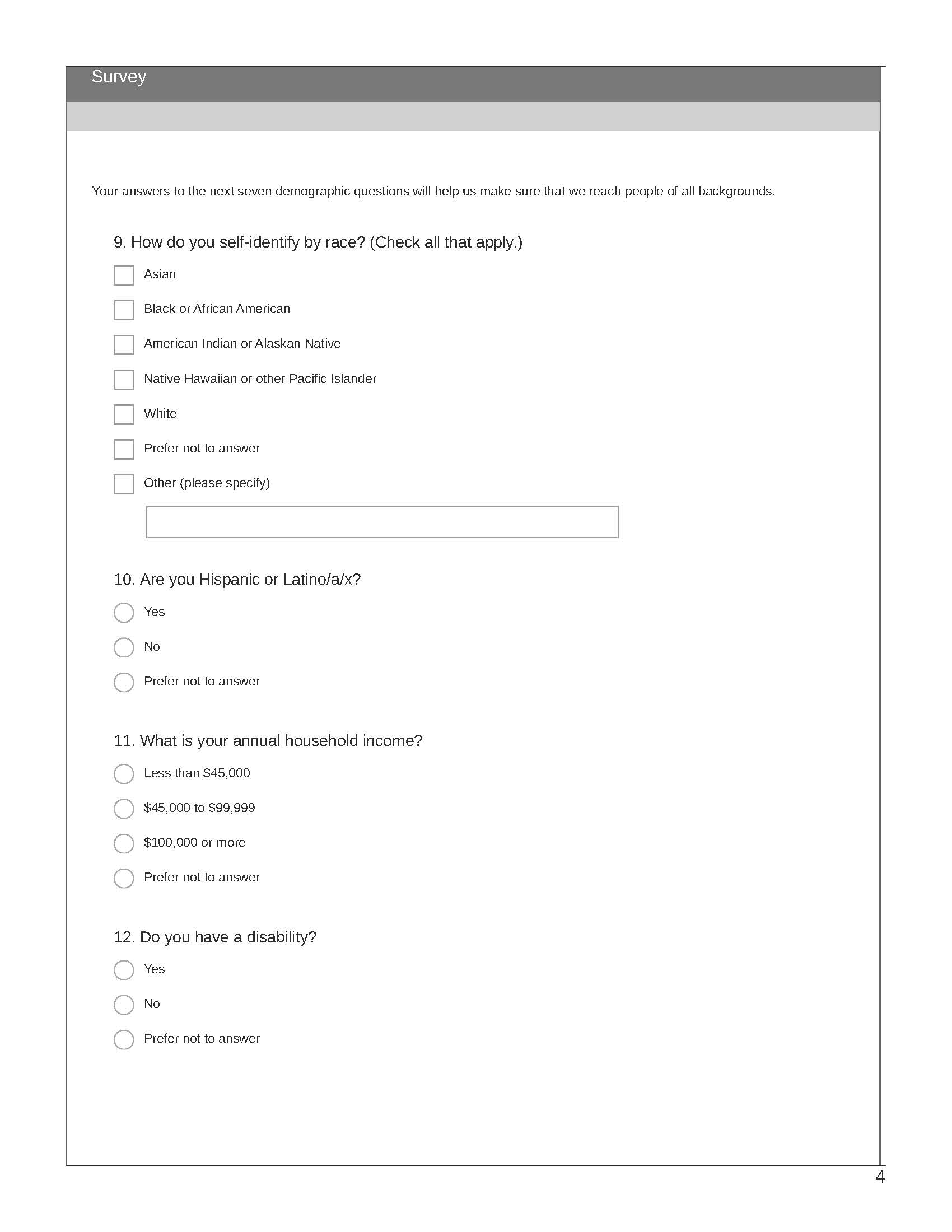
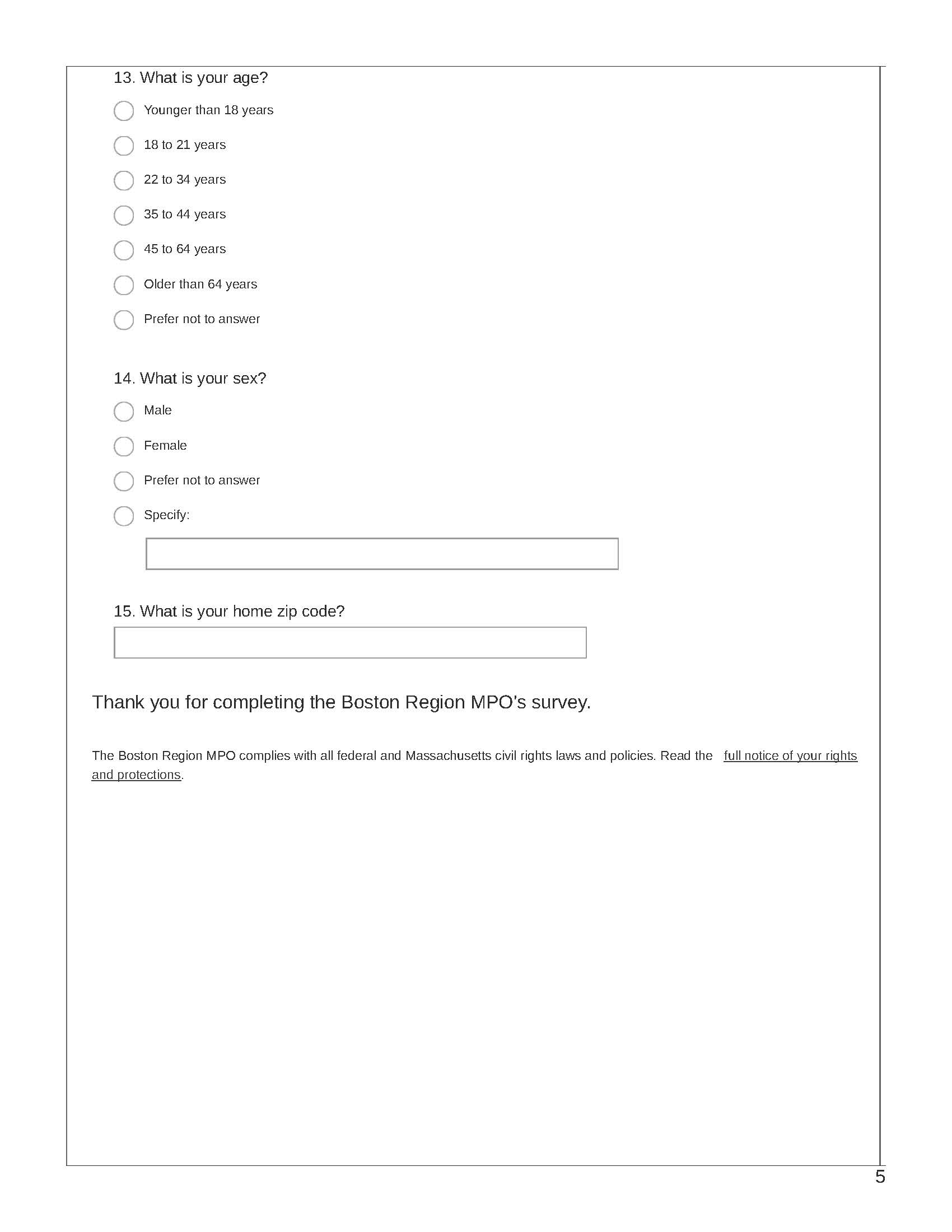
Appendix C—Comment Letters Received During Public Review Period
Lucia Dolan (BLANK@gmail.com) sent a message using the contact form at
https://www.ctps.org/contact.
I strongly support the plans priorities for implementation: Coordinating
public transit services, expanding operating hours, addition new transit
routes where they are currently lacking, and improving accessibility of
infrastructure.
I have a 23 year old son with ambulatory difficulties (uses a cane or
scooter) and a senior in my immediate family. I know they would rather be
with the general population on a bus or train than in a special van, such as
the Ride. I would guess the life cycle costs of making general transit
accessible would be lower than increasing Ride services and it would also
help reduce traffic.
Lynn McWhood (BLANK@earthlink.net) sent a message using the contact
form at https://www.ctps.org/contact.
As a senior with a disability, I appreciate the areas of consideration
included in the Coordinated Public Transit - Human Services Transportation
report. I would like to add that there is a need for improvement in the
design of buses that concerns me. There has been a trend toward reducing the
number of solid vertical support bars in the newer buses and substituting
straps. This greatly increases the possibility of falls and generally makes
it more difficult for people who have less than perfect balance. People need
solid bars to grab on to in order to stand up and feel safe. I have seen
people struggle to stand up because they can't reach the straps while seated,
and I have seen people unable to access open seats once the bus is in motion
because they can't reach a support to allow them to move toward the empty
seat.
ZIP code: 02143
Abby Swaine (BLANK@gmail.com) sent a message using the contact form at
https://www.ctps.org/contact.
As the parent of a young man living in Brookline who is a new manual wheelchair user, I recommend that this draft plan address the following: 1) To the extent that TNCs are expected to substitute for or complement the Ride and taxi service, much effort needs to be made to insure that companies provide WC-accessible vehicles. For motor WC users, that means vans with lifts. For manual WC users, that means hatchback vehicles (SUVs, etc.) for easy stowing of WCs while the rider sits in a passenger seat. Users of Uber and Lyft should be able to search for that sort of vehicle on the app. 2) Snow removal, particularly at intersections, stops and aboveground stations, is a huge barrier to WC users accessing MBTA service in the winter. 3) Too many Green Line aboveground platforms do not provide access to trains for those in WCs. Hynes Convention Center is a hugely important station as a destination and in terms of bus connections, but lacks an elevator. Elevators usually smell like urine. 4) Seating for WC users on commuter rail trains is shabby, wedged in next to bikes and doors. Thanks. At least in my son's case, you could really reduce VMT by addressing
these priorities.
ZIP code: 02445
Donna Barrett (BLANK@yahoo.com) sent a message using the contact form at
https://www.ctps.org/contact.
I am disabled and use power chair for mobility. I live directly across the street from the Franklin/Dean College commuter rail stop. Unfortunately, this rail stop is not wheelchair accessible. In order to access the train I require a ride to either the Franklin Forge Park stop or Norfolk stop. Public transportation to these stops ends at 3pm, therefore it becomes extremely difficult to coordinate transportation to and from Boston due these time constraints. No one is willing to help me to get this accessible.
ZIP code: 02038
Mark Kaepplein (BLANK@gmail.com) sent a message using the contact form
at https://www.ctps.org/contact.
Stop taking away travel lanes to make express lanes for a relatively small number of cyclists. There is often plenty of room to share the road unless stupid protected bike lanes are made which serve nobody. Drivers can't go around vehicles stopped to take left turns and cyclists don't like running the gauntlet of a protected lane sandwiched between parked cars and a curb. It all results in more traffic congestion and more CO2 production. Cyclists usually crash at intersections, not mid-block stretches, so no benefits.
ZIP code: 02474
September 16, 2019
To: The Boston MPO
RE: Coordinated Public Transit / Human Services Transportation Plan (CPT/HST)
First, even though I have come to expect documents of this high caliber from the CTPS, nonetheless, I want to express my appreciation for a well-written, easy-to-read, and very informative CPT/HST. It is great resource for those of us who want to do what we can to improve how transit works for seniors and those with disabilities. It is also a great resource to make us aware of the vast range of options that currently exist.
Below are two comments.
1. For the next cycle, I suggest creating a survey for those in the 50-60 age range in order to get a better sense of how they think transit could best serve them when they become seniors. If we can provide the 50-somethings with the transit system that they think will work for them by the time they are seniors, it may increase the chances that they’ll use transit more.
WRT surveys, I also suggest piggybacking some questions relating to using the system as a senior (or soon-to-be senior) on the online surveys that the MBTA does on a regular basis. If these surveys aren’t suitable vehicles, then the point is do a survey that specifically targets those who are using the MBTA.
2. In the legends of Figures 3-2 and 3-4, it would be more informative to know the ranges of percentages that corresponded to “High,” “Medium-High,” “Low-Medium,” and “Low.”
Try as I might, I don’t have more comments to offer. Again, great job; and now that I am more aware of this plan and its connection to the LRTP, I hope to participate in the next iteration to a greater extent.
Sincerely,
Lenard Diggins (BLANK@gmail.com) Arlington, MA
1 People with disabilities are those who self-identify as having one or more of the following physical and/or mental disabilities: hearing difficulty, vision difficulty, cognitive difficulty, ambulatory difficulty, self-care difficulty, or independent living difficulty.
2 The demographic projections developed for the LRTP identify seniors as the population 75 years of age or older.
3 The population that lives in a household is slightly less than the total population. The total population count includes people who live in group quarters, while the population living in a household does not.
4 Since the Boston Region MPO’s last Coordinated Plan update in 2015, four municipalities have left the Boston Region MPO—Duxbury, Hanover, Pembroke, and Stoughton. They are now part of the Old Colony Planning Commission (OCPC). Applicants in those municipalities should refer to OCPC’s Coordinated Plan.
5 Data are from the 2010 US Census.
6 People with disabilities are those who self-identify as having one or more of the following physical and/or mental disabilities: hearing difficulty, vision difficulty, cognitive difficulty, ambulatory difficulty, self-care difficulty, or independent living difficulty.
7 The demographic projections developed for the Long-Range Transportation Plan identify seniors as the population 75 years of age or older.
8 The population that lives in a household differs from the total population. The total population count includes people who live in group quarters, while the population living in a household does not.
9 Collectively, this input was gathered into a Needs Assessment. The Needs Assessment was used to develop goals and objectives for the MPO that help guide the prioritization of MPO investments, as well as investment programs that lay out of the types of projects that the MPO will fund.
10 There are eight subregions within MAPC. A map of these subregions can be found at mapc.org/get-involved/subregions/.
11 RCCs are voluntary coalitions of transportation providers, human service organizations, advocates, and planners who collaborate to identify and address regional community transportation needs. Each RCC provides an open forum for the exchange of information and sets its own priorities based on member interests and regional needs. More information about RCCs can be found at mass.gov/service-details/regional-coordinating-councils-for-community-transportation.
12 These partner organizations included the RCCs, MassMobility, and MAPC.
13 Respondent affiliation was not gathered for the survey used in phase one.
14 The Boston Region MPO considers a person to be low income if they live in a household in which the annual household income is less than or equal to 60 percent of the region’s median household income. This threshold comes out to be $45,392.